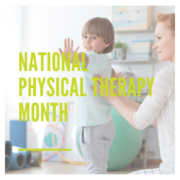National Physical Therapy Month
October is National Physical Therapy Month, which recognizes those who support individuals with physical, occupational, and speech impairments. The American Physical Therapy Association, APTA, devotes the month of October to recognizing the impact that physical therapy can have through their initiative, #ChoosePT. The goal of #ChoosePT is to shed light on physical therapy as an alternative to pain medication, particularly opioids. APTA’s aim is to raise awareness about the benefits of physical therapy for certain injuries rather than resorting to prescribed pain medication. Of course, the use of pain medication is sometimes unavoidable, especially after a major surgery. However, as the opioid epidemic continues to expand, the ages of opioid overdose victims continues to fall into the early 20s and even teens. Now that the opioid epidemic has officially been declared a public health emergency, families must be prepared to identify and combat opioid overuse.
Fast Facts
- According to the U.S. Department of Health and Human Services, over 30% of teenagers consider the typically-abused medications, such as Vicodin and Oxycontin, to be “easily accessible” to teens.
- Surveys indicate that 1 in every 5 high school seniors admits to having taken a prescription drug to get high.
- Shockingly, about half of adolescent users claim to have obtained the prescription drugs illegally from a friend or family member.
- While efforts to combat opioid addictions have increased across the country, the number of adolescent deaths related to overdoses has grown significantly over the last five years.
- While negative peer influence has a major impact on impressionable teens, adolescents with close familial ties, whose parents are more involved and vocal about their disapproval of prescription drugs, are far less likely to engage in their misuse.
Similarly, teens who prioritize their academics are also less likely to abuse opioids. - Because the average adolescent brain is still developing, and doesn’t fully mature until age 25, teens are especially susceptible to risk-taking, impulsivity, peer pressure, and addiction—it is almost as though their brains are primed for seeking the instant gratification that opioids seem to provide.
- Because of the “euphoric” effects, teens with depression, anxiety, or other mood disorders are more likely to engage in prescription drug misuse.
- Adolescents often believe that, because these opioids are prescribed by doctors, they are much safer than the typical “street drugs.” However, the truth is that the addictive properties are the same—making prescribed opioids just as, if not more, dangerous than heroin, fentanyl, etc.
Stay Safe: Strategies for Parents
- When doctors prescribe a post-procedure pain killer for your child, ask about the possibility of an alternative to the typically prescribed opioid. Will a higher dose of ibuprofen or acetaminophen manage the pain?
- If prescription opioids are necessary, follow the dosage instructions carefully; do not exceed the daily dose prescribed by the doctor.
- Monitor the number of pills carefully and secure the prescription yourself; do not leave it up to your teen to administer his/her own doses.
- When pain has been adequately managed, your teen should not continue taking the medication. It is not like an antibiotic where you should finish the full prescription.
- Many doctors recommend flushing leftover pills to avoid their misuse.
- Talk openly with your teen about the dangers of abusing prescription drugs. Remind them that even one instance of abusing a prescribed opioid could contribute to an addiction and/or overdose.
- Stay keen on any mention of a “pharm party,” as these are growing more popular among high school students. At a pharm party, teens bring prescription drugs and other pills to trade or sell. Sometimes pills are tossed into a bowl and passed around like candy, which is why parents must carefully monitor how and where their prescription drugs are stored.




